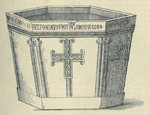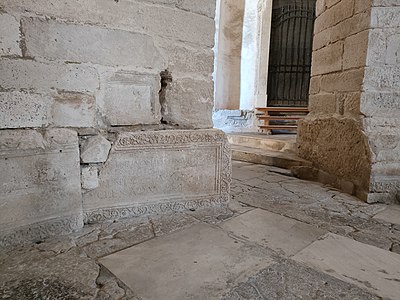
Zadar, historically known as Zara, is the oldest continuously inhabited city in Croatia. It is situated on the Adriatic Sea, at the northwestern part of Ravni Kotari region. Zadar serves as the seat of Zadar County and of the wider northern Dalmatian region. The city proper covers 25 km2 (9.7 sq mi) with a population of 75,082 in 2011, making it the second-largest city of the region of Dalmatia and the fifth-largest city in the country.

The culture of Croatia has historically been influenced by Central European, Mediterranean, and Balkan cultures. Croatia's unique culture and identity can be traced back to the historical llyricum. The Croatian language is believed to have been formed in the 6th or 7th century, with the written language present in Glagolitic texts from the 11th century.

The Pre-Romanesque period in European art spans from the emergence of the Merovingian kingdom around 500 AD, or from the Carolingian Renaissance in the late 8th century, to the beginning of the Romanesque period in the 11th century. While the term is typically used in English to refer primarily to architecture and monumental sculpture, this article will briefly cover all the arts of the period.

Liburnia in ancient geography was the land of the Liburnians, a region along the northeastern Adriatic coast in Europe, in modern Croatia, whose borders shifted according to the extent of the Liburnian dominance at a given time between 11th and 1st century BC. Domination of the Liburnian thalassocracy in the Adriatic Sea was confirmed by several Antique writers, but the archeologists have defined a region of their material culture more precisely in northern Dalmatia, eastern Istria, and Kvarner.

The Krka Monastery is a Serbian Orthodox monastery dedicated to the Archangel Michael, located near the river Krka, 3 kilometres (1.9 mi) east of Kistanje, in central Dalmatia, Croatia. It is the best known monastery of the Serbian Orthodox Church in Croatia and it is officially protected as part of the Krka National Park. It was established around 1577 or later on the ground of previous Gothic-Romanesque style Catholic church.

The Cathedral of St. Lawrence is a Roman Catholic triple-naved basilica constructed in Romanesque-Gothic in Trogir, Croatia. Since its construction lasted several centuries, it illustrates all the styles that succeeded one another in Dalmatia. It serves now as the most imposing monument in the city of Trogir.
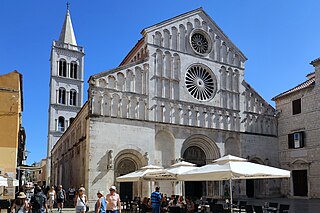
The Cathedral of St. Anastasia is the Roman Catholic cathedral of Zadar, Croatia, seat of the Archdiocese of Zadar, and the largest church in all of Dalmatia.
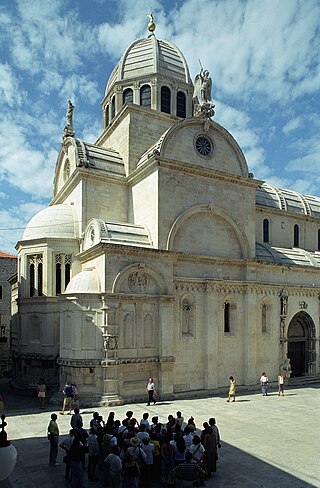
The architecture of Croatia has roots in a long history: the Croats have inhabited the area for fourteen centuries, but there are important remnants of earlier periods still preserved in the country. The historic architecture of most old towns on the coast is Venetian, a legacy of the Venetian empire. The Habsburg and Ottoman empires also influenced the architecture of the region.
Croatian art describes the visual arts in Croatia, and art by Croatian artists from prehistoric times to the present. In Early Middle Ages, Croatia was an important centre for art and architecture in south eastern Europe. There were many Croatian artists during the Medieval period, and the arts flourished during the Renaissance. Later styles in Croatia included Baroque and Rococo.

Donatus, also called Donato of Zara, was a Dalmatian saint who became a bishop and a diplomat for the Dalmatian city-state of Zadar (Zara). His feast day is celebrated on 25 February.

The Church of the Holy Salvation or Holy Saviour was a Pre-Romanesque church in the Dalmatian Hinterland, Croatia, whose ruins are now a historic site. It is located in the small village of Cetina, near the spring of the river Cetina, 8 km northwest from the town of Vrlika.
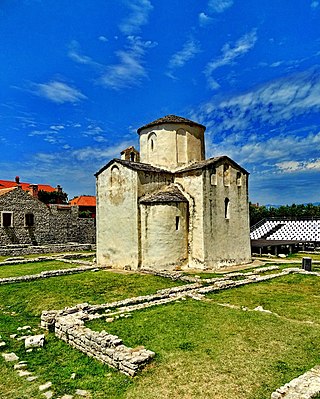
Church of the Holy Cross is a Croatian Pre-Romanesque Catholic church originating from the 9th century in Nin.

Hollow Church is the archaeological excavation of what used to be a Romanesque Roman Catholic church in the 11th-century Salona, Croatia.

Bribir is a village in Šibenik-Knin County, near the town of Skradin, in southern Croatia. In its location in the Roman period was town Varvaria, while during the medieval times it was an important and rich settlement with a stronghold and Franciscan monastery, a capital city of power of the Šubić family.

Croatian Pre-Romanesque art and architecture or Old Croatian Art is Pre-Romanesque art and architecture of Croats from their arrival at Balkans till the end of the 11th century when begins the dominance of Romanesque style in art; that was the time of Croatian rulers.
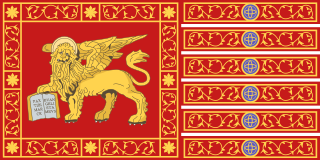
Venetian Dalmatia refers to parts of Dalmatia under the rule of the Republic of Venice, mainly from the 15th to the 18th centuries. Dalmatia was first sold to Venice in 1409 but Venetian Dalmatia was not fully consolidated until 1420. It lasted until 1797, when the Republic of Venice fell to the forces of Napoleon Bonaparte and Habsburg Austria.

The Church of St. Dunat is a Roman Catholic church located on the island of Krk, Croatia.

Church of Holy Trinity is a Pre-Romanesque style Roman Catholic church located in Split, Croatia. Out of all early-medieval architectural monuments in Dalmatia, which historians date back to the period between 8th and 11th century, Church of Holy Trinity, with its original shape and rich findings, has a very important place. This small central edifice with six-leaf structure of semicircular arches strung around irregular circle has become one of the most precious heritage monuments of Split and Dalmatia.
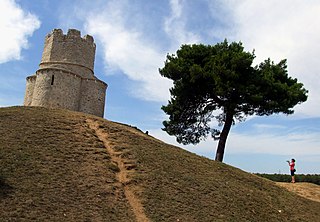
The Church of St. Nicholas is a late 11th or early 12th century Pre-Romanesque style Roman Catholic church located in the field of Prahulje, one mile from Zadar, between Zaton and Nin in Croatia. It was built on the earthen pyramid mound on top of the Liburnian prehistoric tomb.
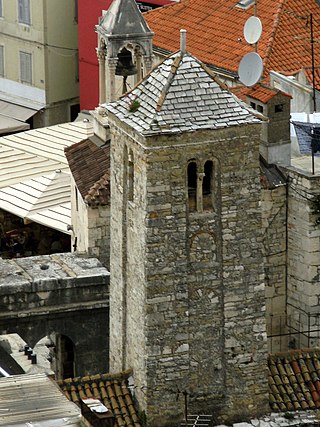
The Belltower of the Church of Our Lady of the Belfry is a disused Roman Catholic church in Split, Croatia. Built into a small space within the ancient Iron Gate of Diocletian's western wall. Today little survives of the building, apart from the belltower, one of the oldest in Croatia.


